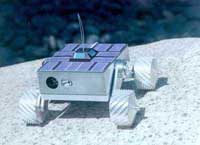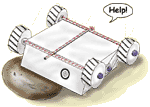
|
The MUSES-CN nanorover will be the smallest rover ever to fly on a space mission. (MUSES stands for the Mu Space Engineering Spacecraft--which is being built by the Japanese Institute of Space and Astronautical Science--C means it is the third in a series, and N stands for NASA's part in it, which is to build the nanorover.)
The nanorover wheels are attached to struts--kind of like our toy nanorover, except that each wheel of the real nanorover operates independently, rather than in pairs. Why do you suppose it is designed this way?
Well, gravity can be a wonderful thing. We take it for granted here on Earth. But on asteroid 4660 Nereus, there is so little gravity that a rover will barely stick! The nanorover weighs one kilogram (a little over two pounds) here on Earth. But on Nereus it will weigh only 1/10th of a gram. A penny weighs 30 times more! A little bump will make the nanorover bounce way up in the sky and could easily flip it over. So it needs to be designed to operate even if that happens.
If the nanorover were to flip over, its struts can rotate to put the wheels back down on the ground! Solar energy cells on its belly will be able to provide enough power to get it turned back over.
There is another clever thing about this design. When the struts move the wheels close together, the body of the rover can rotate so that its camera points straight up or straight down.
The nanorover doesn't just roll on its wheels. It hops! The strut design lets it hop 20 centimeters (8 inches) per second. Rolling, it can go only 1 millimeter per second in the tiny gravity of Nereus. At this rate, it would take 18-1/2 days to go one mile! So, as you can see, The Space Place toy nanorover is a real hot rod!
Here is a computer animation of the nanorover hopping over a big crack. (900-Kb .mpg file).
|
 |
 |
 |
 |
 |
 |
|
| |||||

